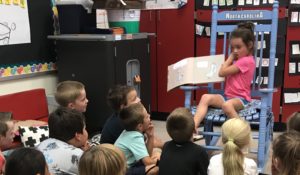Helping students overcome their apprehensions is key to promoting reading success.
Neuroscience reveals that reading impacts both the cognitive and affective parts of the brain.
When students struggle to develop reading skills as expected, they become discouraged and frustrated as a lack of confidence, low self-esteem, and anxiety quickly progress. A downward spiral evolves, producing young learners who may eventually give up and shut down. These unpleasant feelings become associated with reading, and then negatively impact the potential for essential literacy skills to advance while adversely setting a climate for further learning obstacles and impairments to unfold as the child grows.
When supporting struggling readers, teachers and parents should address not only the academics but also the mental and emotional aspects that stem from educational deficits.
By weaving techniques that establish a culture of positivity and success into learning while supporting struggling readers, educators commit to creating a safe environment that fosters a sense of achievement. These techniques can include an effective multi-sensory instructional approach that explicitly teaches phonological awareness, phonology, syllabication, syntax, semantics, and morphology. By expanding ways in which struggling readers can learn, negative feelings can turn into positive ones as skills expand and reading transforms into an enjoyable experience.
Establish Realistic Expectations
Success leads to success and too often, failure leads to more failure. When the learning targets feel out of reach, struggling readers can become discouraged and overwhelmed. When educators construct achievable goals that tap into the unique strengths of the student, the path to supporting these struggling readers can change and start heading in the right direction. It is important to create opportunities for immediate and authentic success by breaking tasks up into small incremental steps that focus on mastery and not on memorization.
Attainable daily and weekly outcomes will help to motivate struggling readers when accompanied by explicit multimodal instruction that simultaneously engages the visual, auditory, and tactile/kinesthetic pathways. Practice, practice, practice! Permit as much repetition as necessary until the learners progress and accomplish the intended skill.
Echoing the words of Anna Gillingham, “Go as fast as you can, but as slowly as you must” to build confidence and encourage reluctant readers.
Focus on the Positives
When children believe they can’t read, then they won’t read. It is a simple equation. Educational support must meet students “right where they are” through instruction that celebrates their abilities and provides the opportunity to shine. Give encouragement even during these rough times by focusing on readers’ strengths and making them aware of the triumphs.
Hasbrouck (2020) explains the importance of expressing total confidence in the ability of the child to learn by underscoring the positives in the face of challenges without overpromising a certain outcome. She stresses, “The time struggling readers spend reading independently, without the opportunity to have errors corrected or to receive encouraging support and feedback, can often serve to deepen their mis-learnings and reinforce common, frequent errors.”
Providing immediate, specific, and honest feedback to build reading esteem will help learners to see the growth, adjust their mindset, and become aware of what they CAN do.
Encourage and Reward Risk-Taking
When struggling readers stumble on words, are unclear about expectations, don’t understand a text, or make incorrect responses, their weaknesses are exposed, and confidence crumbles.

Reading is undoubtedly risky, and failure is a necessary component of success. A safe and supportive learning environment makes it clear to students that mistakes are not only expected but are welcomed. The bumps along the road lead to some of the greatest periods of growth and are a vital component in the learning process.
Miscues should become teachable moments and be addressed through scaffolded instruction. Support students using a gradual release of responsibility model or an “I do, We do, You do” approach to strengthen understanding by first modeling, then guiding practice, and finally giving independent practice.
Encourage students to ask questions about their reading and let them know that even if they cannot read a passage and understand it right now, that doesn’t mean they won’t be able to in the future. Praise endurance as struggling readers advance through more challenging texts.
Make progress visual by highlighting growth on a phoneme/grapheme chart or by logging improved speed and accuracy on a rapid word chart or reading passage. Change the focus away from needing to have the right answer, and redefine success as the perseverance to stick with a task and the resilience to accomplish a goal.
Build Positive Relationships
Relationships matter and will be the most important piece of the puzzle to help reluctant, struggling readers overcome the obstacles that hold them back! The old adage “students don’t care how much you know until they know how much you care” resounds throughout every interaction with a struggling reader.
Hattie’s research reveals the power of developing positive relationships with students, ALL students — to ensure they read, write, communicate, and think at high levels (Fisher, Frey & Hattie 2016). Having a network of teachers and parents that truly want to help and will be a support each step of the way is vital to building the courage that turns struggle into a journey of success.
Connections that are built on genuine trust and respect mold students who understand they are not alone and as a result, they are motivated to dig their heels in, step out of their comfort zone and take uncomfortable risks needed to succeed.
Embrace students’ efforts, by acknowledging that having difficulty learning to read is not their fault, but it is their challenge to overcome and that improvement will take time and hard work. Instill a sense of responsibility and ownership of their own learning into students. Offer decision-making opportunities that will engage the interests of your students and give them some control.
“One of the most rewarding experiences I can imagine is seeing a child who once was sad and defeated transformed into one who glows with an eagerness to learn” (Shaywitz, 2003).
When safety nets are in place, and struggling readers feel good about themselves and their reading achievements, they will likely take risks that lead to progress and skill growth. Within this trusted and supported environment, they can learn to push aside their apprehensions and no longer need to avoid reading tasks.
With increased fluency and more accurate reading and spelling, motivation and perseverance levels increase and confidence is built that overpowers fears, dissolves butterflies in the stomach, and conquers the obstacles that once seemed impossible. A determined “I AM A READER” attitude emerges, forging continued success and ultimately, lifelong learning.
References
Fisher, D., Frey, N., and Hattie, J. 2016. Visible Learning for Literacy, USA: Corwin.
Hasbrouk, J. 2020. Conquering Dyslexia: A Guide to Early Detection and Intervention for Teachers and Parents, New York: Benchmark Education.
Shaywitz, S. E. (2003). Overcoming dyslexia: A new and complete science-based program for reading problems at any level. New York: A.A. Knopf.
About The Author
With over 25 years of experience, Stephanie Sawhney has taught preschool through 7th grade and has led staff development and literacy workshops for teachers. She is a certified Reading Specialist, ESL Teacher, Elementary Education Teacher, Special Education Teacher, CERI Certified Structured Literacy Dyslexia Interventionist, and IMSE Level 5 Master Instructor. Stephanie received her BS from Clarion University of Pennsylvania in Elementary and Special Education, her MS in Reading Education from Queens College, CUNY, and her ESL Endorsement from Drexel University. She is currently a RTI Literacy Coach/Orton-Gillingham Coach and works to support and guide teachers through effective implementation of IMSE’s OG. She privately tutors several students using both the comprehensive and intermediate methodologies and serves as a practicum supervisor for IMSE. She was a member of the review team for the 3rd edition of Reciprocal Teaching at Work by Lori Oczkus. Stephanie loves the POWER of IMSE’s Orton-Gillingham to change lives as it empowers teachers to provide quality literacy instruction that then empowers their students to become confident, capable readers!

